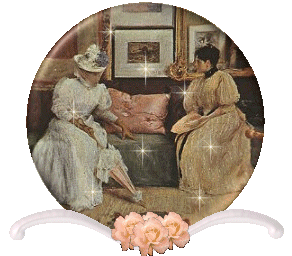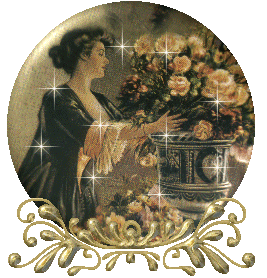|

This section will take you back in time. Come learn about the clothing women and men wore during the Victorian period. You will be bedazzled by the attirements. Maybe it will even inspire you to collect some Victorian costumes for your private enjoyment.
Women's Clothing in the Victorian Era
Since this era spanned such a long period in
history, it saw quite a lot of changes in women's
dress. At the beginning, in the 1820's, women
were actually working at being seductive. As
time went on, the fashions became almost
prudish and very constricting. Some of the
attire was downright hilarious!! Here is a brief
history of Women's Clothing in the Victorian Era.
In the 1820's, women's dresses were quite sheer
and gauzy. Most of the dresses were made of
a thin muslin, buttoned up the back and were
cinched just below the breasts to give the illusion
of a high waist. Oftentimes, all that was underneath
was a light chemise. As the dresses had no
pockets, most ladies carried their personal items
in a small bag called a "reticule."
Sometimes a sleeveless top called a pelisse that
went down to the thigh was worn over the dress. Others wore a shorter jacket called a spencer.
Ladies always wore something on their heads -
inside it was a cap, and outside they wore bonnets.
The shoes resembled slippers. When it was raining,
something called a patten was attached to the
shoes to raise the ladies an inch or two. This
contraption was basically metal rings on small
stilts.

In the 1830's and 1840's, styles leaned more toward
the women having a bell shape. The waistline
dropped to the more normal location and the skirts
were much fuller due to the mass of horsehair
petticoats the women began wearing.
The materials used for clothing changed as well -
more luscious and heavier fabrics such as
velvets and silks became available. The gauzy
look was not "in vogue" anymore and dresses
became tighter and tighter. Many tops had
stays made of bone that often restricted breathing.The attire became more ornamented. Feathers
and jewels were seen in abundance. This often
made the dresses and hats very heavy and
awkward to wear. But - oh the beauty!
In the 1850's and 1860's, the petticoats gave way
to something called the "cage crinoline." This
new invention resembled an upside down,
cone-shaped trellis. While it enabled the ladies
to dispense with all the layers of petticoats, it
brought along even more problems!
The cage crinoline was very hard to fit through
doorways, difficult to sit down in and very
embarassing if you were caught in the wind!
Due to the lack of petticoats, it could also cause the
wearer to be very cold during the winter!
Many ladies took to wearing red flannel petticoats
and eventually what was called back then
"drawers"!
Toward the end of the 1860's, the cage crinoline
disappeared to be replaced by the bustle. This
newfangled piece of apparel was worn on the
ladies' derrieries underneath their skirts.
It was often thought the bigger the bulge in the
back the more beautiful!
The bustle disappeared for a while in the 1870's,
but gained popularity once again in the 1880's.
During this time, the tea dress was invented - giving
ladies something pretty and elaborate to enjoy.
As more and more women became interested in
sports such as tennis and bicycle riding, the first
sporting apparel began to make an appearance.
All of this attire could be very time consuming to
put on, as well as confusing as to what to wear
when! The more well-to-do ladies needed at
least 6 different outfits - a walking dress, a country
dress, a visiting dress, an evening dress, a dinner
dress and a ball gown. All had to be worn for the
proper occasion and coincide with the fashion
of the day.


|